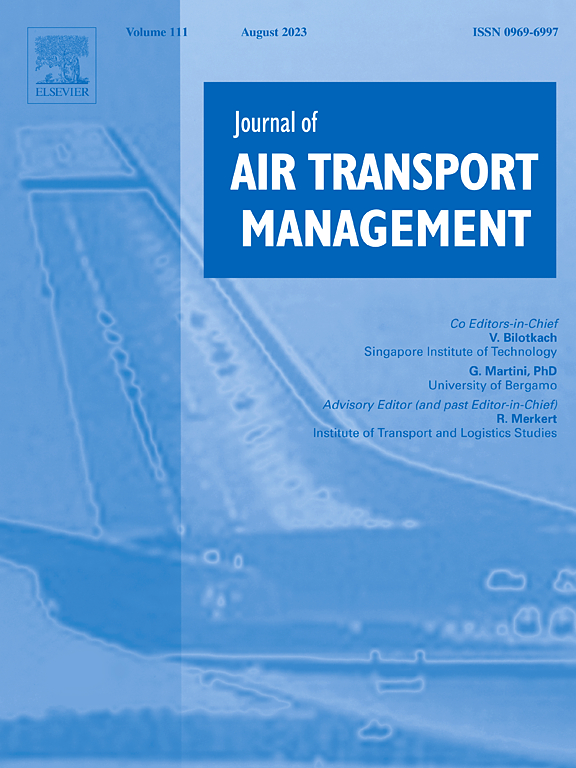Investigating cargo capacity determinants in desertic airports using Bayesian Network (BN) analysis
IF 3.6
2区 工程技术
Q2 TRANSPORTATION
引用次数: 0
Abstract
Since the inauguration of Kuwait International Airport in 1960, Kuwait's transition from an oil-based economy to a key aviation industry player in the region has been marked. This study investigates the cargo capacity determinants at Kuwait International Airport (KIA) from 2011 to 2021, employing Bayesian Network (BN) analysis. It dissects aviation data into two five-year periods to discern time-sensitive influences on the aviation network, focusing on scheduled and non-scheduled cargo flights. The study tests economic factors like GDP, population, jet fuel prices, inflation rates, and exchange rates. Results indicate that GDP and exchange rate are pivotal for cargo capacity throughout the decade. In the first five years, the exchange rate solely influenced cargo capacity, while in the latter half, both the exchange rate and inflation were significant factors. Additionally, cargo capacity was indirectly impacted by fuel prices through inflation. A sensitivity analysis reveals the varying impacts on cargo capacity: inflation had the highest sensitivity, causing a 36 % increase in cargo capacity for a 7.5–15.5 % inflation rate increase during 2016–2021. Exchange rates and fuel prices followed with 32 % and 14 % sensitivity, respectively. The study also notes that changes in GDP and exchange rates had relatively minor effects on cargo capacity in the first half of the decade. This abstract summarizes the research's aim, methods, and crucial findings, emphasizing their relevance in understanding cargo capacity dynamics at KIA amidst Kuwait's economic evolution.
利用贝叶斯网络(BN)分析研究沙漠机场的货运量决定因素
自1960年科威特国际机场落成以来,科威特已从一个以石油为基础的经济体转变为该地区重要的航空工业参与者。本研究采用贝叶斯网络(BN)分析,调查了2011年至2021年科威特国际机场(KIA)货运能力的决定因素。它将航空数据分成两个五年期,以辨别对航空网络的时间敏感影响,重点关注定期和不定期货运航班。该研究测试了GDP、人口、航空燃料价格、通货膨胀率和汇率等经济因素。结果表明,GDP和汇率是整个十年货运能力的关键。在前五年,汇率仅影响运力,而在后五年,汇率和通货膨胀都是重要因素。此外,由于通货膨胀,货运能力受到燃料价格的间接影响。敏感性分析揭示了对货运能力的不同影响:通货膨胀的敏感性最高,在2016-2021年期间,通货膨胀率增长7.5 - 15.5%,导致货运能力增长36%。其次是汇率和燃料价格,敏感度分别为32%和14%。该研究还指出,在本十年的前五年,国内生产总值和汇率的变化对货运能力的影响相对较小。本摘要总结了研究的目的、方法和关键发现,强调了它们在理解科威特国际机场在科威特经济发展中的货运能力动态方面的相关性。
本文章由计算机程序翻译,如有差异,请以英文原文为准。
求助全文
约1分钟内获得全文
求助全文
来源期刊

Journal of Air Transport Management
TRANSPORTATION-
CiteScore
12.40
自引率
11.70%
发文量
97
期刊介绍:
The Journal of Air Transport Management (JATM) sets out to address, through high quality research articles and authoritative commentary, the major economic, management and policy issues facing the air transport industry today. It offers practitioners and academics an international and dynamic forum for analysis and discussion of these issues, linking research and practice and stimulating interaction between the two. The refereed papers in the journal cover all the major sectors of the industry (airlines, airports, air traffic management) as well as related areas such as tourism management and logistics. Papers are blind reviewed, normally by two referees, chosen for their specialist knowledge. The journal provides independent, original and rigorous analysis in the areas of: • Policy, regulation and law • Strategy • Operations • Marketing • Economics and finance • Sustainability
 求助内容:
求助内容: 应助结果提醒方式:
应助结果提醒方式:


